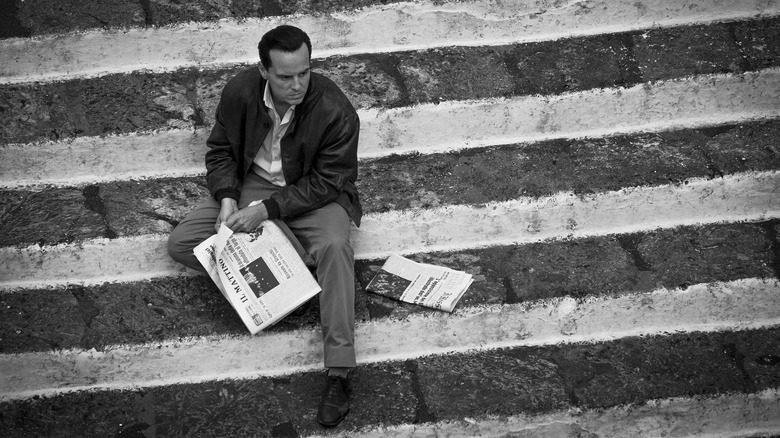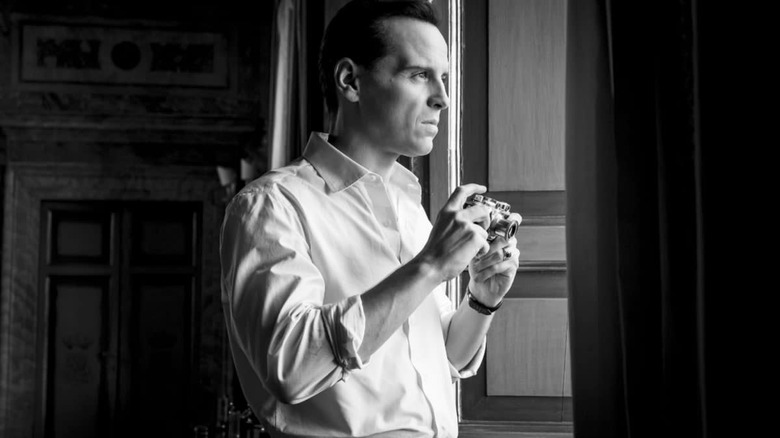Netflix's Ripley Made A Creative Decision That Has A Lot Of Viewers Complaining
The character of Tom Ripley first appeared in Patricia Highsmith's 1955 novel "The Talented Mr. Ripley," a salacious story about a con man who is hired to locate an old school chum named Dickie Greenleaf but who ends up becoming obsessed with him, killing him, and supplanting him. Ripley is not a charming con man, but he is staggeringly clever and possesses a talent for subterfuge. He's also driven by his baser desires, unable to resist pursuing the women and men he lusts after (Ripley is likely bisexual) or stealing the money he so desperately wants. Each time, Ripley gets away with it, as evidenced by the fact that he starred in five novels published through to 1991.
A critic once pointed out that Tom Ripley's character arc is a direct inversion of traditional storytelling. A typical crime novel protagonist will learn new things as the story progresses and then use their wits to solve a crime. Ripley begins his stories by committing crimes and then spends the back half desperately digging himself out and evading police capture.
Highsmith's Ripley novels have been adapted to film several times. Alain Delon played Ripley in "Purple Noon" (1960), while Dennis Hopper played him in "The American Friend" (1977). Perhaps most famously, Matt Damon played Ripley in "The Talented Mr. Ripley" (1999), with John Malkovich playing him in 2002's "Ripley's Game" and Barry Pepper taking on the role in "Ripley Under Ground" in 2005. Most recently, Andrew Scott played Highsmith's con man in the new Netflix series "Ripley," which dropped on April 4, 2024.
Although "Ripley" has been pretty well-received, some viewers aren't finishing it for a rather silly reason. According to the Independent, audiences are turning "Ripley" off merely because it was filmed in black-and-white.
Moaning about monochrome
The Independent quoted several anonymous viewers about the show's black-and-white photography, each of them complaining openly about the lack of color. "Why on Earth is 'Ripley' filmed in black and white?" one whined. "Surely the only reason to not film in color previously was technology. Totally killed it for me, the dog seems quite okay with it though." Another viewer felt it was a lost opportunity to film the beautiful Italian seaside setting in color, although they concluded with a quip, noting that the book was also in black-and-white.
A third viewer assumed that black-and-white photography was a cost-saving measure, perhaps recalling a period from 40 years ago when black-and-white film stock was cheaper than color film stock. That viewer perhaps didn't know that cinematographer Roger Elswit shot "Ripley" with Arri Alexa LF digital cameras, which don't require the purchase of 1970s black-and-white film stock.
It seems that show creator Steve Zaillian came to the decision to shoot his series in black-and-white based on his personal memories of reading Highsmith's novel. In an interview with Vanity Fair, Zaillian explained:
"The edition of the Ripley book I had on my desk had an evocative black-and-white photograph on the cover. [...] As I was writing, I held that image in my mind. Black-and-white fits this story — and it's gorgeous."
Zaillian's last point seems to be lost on his viewers. Black-and-white photography is gorgeous. Shooting without color adds a shimmering, hyper-real texture to photographed images. A rundown shack or dingy apartment is dull when shot in color, but breathtakingly alive in black-and-white. Taking the color away from images can make them abstractions, an idealized version of the thing, rather than just the thing itself.
Certain viewers failed to realize that the showrunners thought of that.
Aversion to black-and-white media, and how to cure yourself
One has to wonder why some audiences still have an aversion to black-and-white movies and shows despite many recent artists choosing to shoot in the format. "Oppenheimer," "Poor Things," "The Tragedy of Macbeth," "Belfast," "C'Mon C'Mon," "Malcolm & Marie," "Passing," "Roma," "Mank," and "The Lighthouse" were all made either partly or fully in black-and-white while color films like "Nightmare Alley," "Godzilla Minus One," and "Mad Max: Fury Road" all saw black-and-white re-releases. Many of those films were awards darlings and several of them were legit mainstream hits ("Oppenheimer" most notably).
One could point out that because black-and-white photography was the standard format throughout the 1910s, '20s, '30s, and '40s, modern audiences may associate the look with the past, age, and antiques. Incidentally, the first color feature film was "With Our King and Queen Through India," shot in 1912. Color film wasn't as commercially viable at the time (it would require too many tech upgrades to theaters), so it didn't become more widely used until the 1930s. Watch Michael Curtiz's "Doctor X" (1932) sometime and marvel at the two-strip Technicolor process.
Audiences, I posit, don't have an aversion to black-and-white necessarily, but an aversion to watching older movies. Modern audiences have been trained to consume nothing but novelty, focusing on whatever is new that week rather than openly talking about a broad, explorative cinema experience. In the streaming era, random older TV shows occasionally become hits as they are discovered, hence everyone suddenly talking about "Suits" or "Bones" or "Friends" again in the 2020s.
Complaining about black-and-white photography is, if I may interject, a little childish. It merely shows that the viewer hasn't watched much black-and-white media, revealing only their unwillingness to watch some of the best movies and shows of all time.


